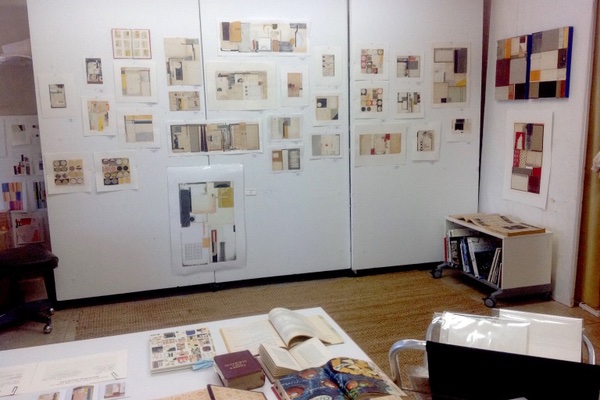Never a lack of the experimental
Melinda Tidwell was born in a small town in the Rocky Mountains of northern Utah. She attended university in Salt Lake City and graduated with honors in Mathematics. Her lifelong interest in abstraction, books, and vintage materials now finds expression in her work as a fine artist. She lives in Santa Fe, New Mexico, with her husband and fellow artist Jonathan Keeton, three cats, and two dogs, where she pursues her abstract art with collage.
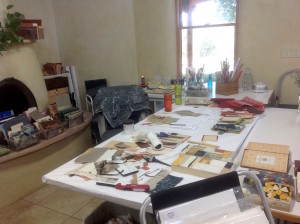
from mathematical abstraction to abstract art
Your medium is collage, but you have a background in mathematics and computer graphics. Can you tell us how this background may have or still does influence your work?
Well, I did a lot of work in Photoshop, designing storyboards for motion graphics, and this is very much like collage because you can try out a lot of variations of your design. I was used to that elasticity, and getting off the computer and into real materials was astonishingly fun.
[dropcap]C[/dropcap]ollage makes composition so immediate and fun, I like to focus on that: abstract composition.
The math connection is more subtle, but math is in itself an abstract language that can describe and help us to understand lots of phenomena. Abstract art is a language that tries to describe things that are much more ineffable, much harder to wrap your mind around, like our own feelings and experiences of being human in this time, this place, this society. I still like the order of math and I do pretty ordered work in my abstract art.
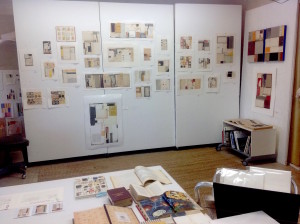
Santa Fe, New Mexico
How and when did you make the move from the mathematical to abstract art?
It became clear in college that I could not stay with just math much longer. The whole emotional side of life was bursting out everywhere by that point, and I was much more drawn to the humanities and the arts. I did want to have a job after college, though, so I jumped into this new field that was combining computers and art for movies and commercials. For a long time in my work as a computer-graphics artist, I was using both of these skill sets. CG, as it is known, was very technical back in 1985, when I got started. The math I already knew and could use, and my eye was becoming better trained each year.
the book exchange…
like going to a room of a million voices
How did you come about using discarded books as your source for collages?
I found this teacher whose work I liked very much, her name is Lisa Kokin. I started taking workshops from her and was really hooked on books from the beginning. I have always liked to learn and always had lots of books around, so there was a comfort level with the material that I did not feel with anything else. Also, a used bookstore is sort of a reflection, or abstraction, of our society and its recent history. Every subject is there and reflects all kinds of lifestyles. High school textbooks, cook books, children’s books, the greats of literature, plays, poetry, pulp fiction, books of maps, encyclopedias–and then all of this from times gone by, like the 50’s and 60’s, etc. These trips to the book exchange were like going to a room of a million voices. Kind of crazy, really.
[dropcap]A[/dropcap]bstract art is a language that tries to describe things that are much more ineffable, much harder to wrap your mind around, like our own feelings and experiences of being human in this time, this place, this society.
What other materials have you used in your collage?
I really like the dot pattern in billboard papers. Of course, I alter the book materials, with paints and inks, graphite. Sometimes I use fabric or wire, or even nails. Sometimes vintage magazines. But, so far, it’s mostly book parts.
You teach collage out of your studio. Do you have a basic premise about the art of collage that serves as a foundation for your teaching?
Collage makes composition so immediate and fun, I like to focus on that: abstract composition. The books themselves provide so much richness with words and textures, pictures, that I find the biggest challenge is to get it all to come together on the page and make a sort of visual sense that is alluring and interesting. Many times we just load too much onto a collage, and so it is about simplifying and subtracting. Other times, the work is not yet alive, it needs more energy and interest to give it a voice. I like to work with design principles to talk about how to strengthen and clarify the work.
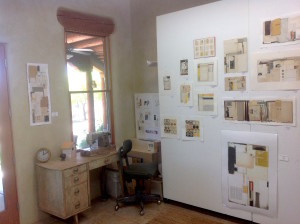
a larger investigation into mark making
How has your work changed in the past few years?
It’s definitely moving towards bigger and more colorful. And yet, I circle back into black and white, or smaller, too. It seems to me I keep reworking the same themes in new ways. Sometimes I want very spacious compositions, sometimes very packed together.
What kind of allowances do you make in your work for the experimental?
I don’t know if there is ever a lack of the experimental in art. It always feels like I don’t know what I am doing. I may have glued a few things down, but I don’t know how to make it work from there. I just keep trying things until something strikes or I have to put it aside for awhile ‘cause it is just unyielding. I may pick it up a year later and start experimenting with it again but it feels like The Unknown is ever close at hand.
What are you working on in your studio right now?
I am doing a number of things right now. I am taking a printmaking class and learning more about mono types, lino cuts, etc. This is part of a larger investigation into mark making with inks, paints, and papers. My husband and I are experimenting with making really large renditions of my book collages which is particularly challenging. I have done a couple of them as paintings but we are experimenting with different media as well. And I like to keep a steady practice of just making the smaller collages from books.
[dropcap]I[/dropcap]t always feels like I don’t know what I am doing. …I just keep trying things until something strikes or I have to put it aside for awhile ‘cause it is just unyielding.”
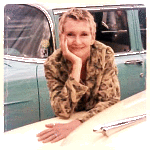
What does your typical studio day look like? I try to get to the studio by 9 am and put in two hours, stop for lunch, then do more. But since I work out of my home, the blend of household and art-making is pretty fluid. And there is a lot of marketing and business work to be done. I am writing a new blog post, or getting people signed up for classes, or shipping work to galleries, or posting new work to social media, updating my website. Some days my real studio time is 6-9pm. It’s sort of like a collage, all over the place.
What other artists’ works do you have or wish you could have displayed in your own home?
Oh well, I would love a few Rauschenberg and a Diebenkorn (Ocean Park Series). I would treasure a Lisa Kokin book collage. Or many of the pieces in my gallery here in Santa Fe, Nisa Touchon Fine Art. Right now, my work, my husband’s paintings, and some beautiful glass pieces by Lisa Peterson fill my home.
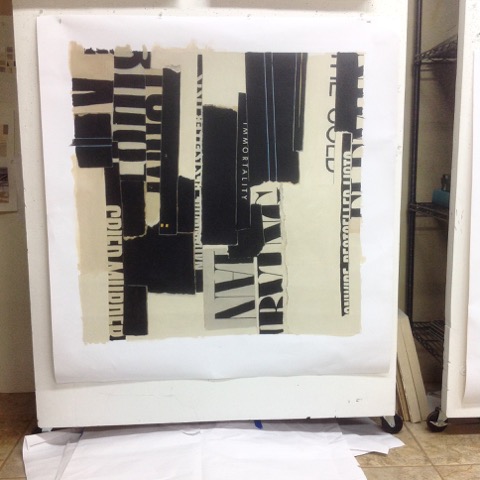
Melissa Tidwell
See Melinda Tidwell’s work in The Woven Tale Press Vol. IV #2

